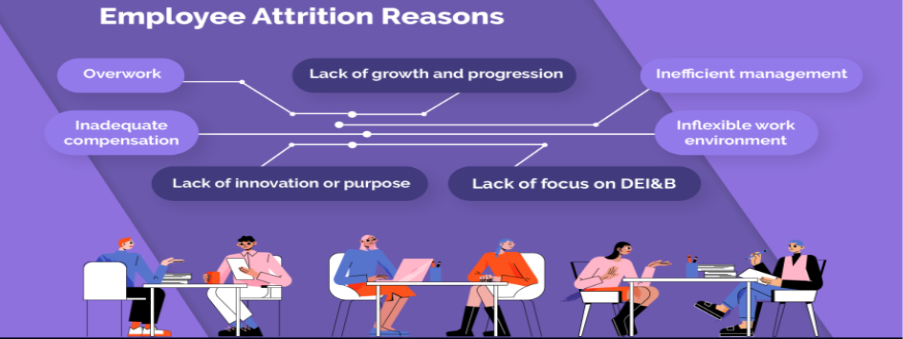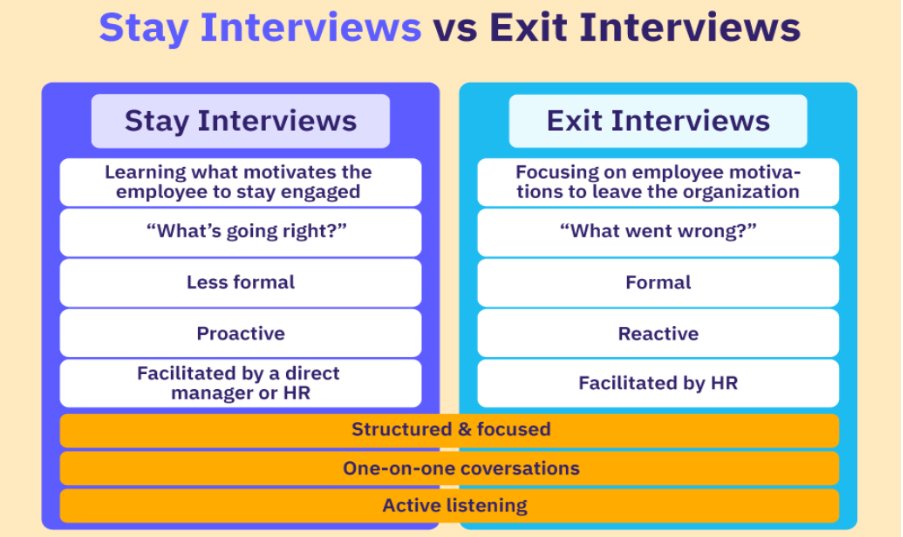Work Related Concerns
Understanding Employee Attrition: A Complete Guide for Indian Workplaces

.png)
Written by
Aarohi Parakh,
Psychologist and Content Writer

Reviewed by
Sanjana Sivaram,
Psychologist and Clinical Content Head

Introduction to Employee Attrition
In today’s fast-evolving business landscape, employee attrition has become a key challenge for Indian organisations striving to build resilient, people-centred workplaces.
Take the example of Aditi, a 29-year-old software engineer from Bengaluru. After four years at a mid-sized IT firm, she began to feel stuck — her workload was rising, promotions seemed uncertain, and she often carried work stress home. When a global company offered her a flexible hybrid role with better pay and learning opportunities, she decided to move on. Her employer, like many others, suddenly found itself short-staffed, scrambling to fill her position while existing team members absorbed the extra work.
Whether it’s an IT firm facing frequent resignations like Aditi’s, a manufacturing plant dealing with skilled labour shortages, or a startup struggling with burnout, understanding attrition and addressing its causes is vital to sustaining productivity and morale.
This guide breaks down what employee attrition really means, why it matters, and how HR and business leaders can strategically reduce it.
What is Employee Attrition?
Attrition is a gradual workforce reduction caused by employee retirements, resignations, deaths or elimination of positions without immediately filling vacancies.
In HR, attrition goes beyond headcount. It reflects the organisation’s ability to retain talent, maintain morale, and sustain operational continuity.
Attrition vs Turnover: Key Differences
While the two terms are often used interchangeably, there’s a key difference:
- Attrition occurs when employees leave and are not replaced immediately or at all. It signals a long-term reduction in the workforce.
- Turnover, on the other hand, implies that the employee leaving is replaced by another, keeping the workforce size stable.
- For example, if a company’s customer service team of 20 loses two employees and chooses not to refill those roles due to automation, that’s attrition. If it hires replacements, that’s turnover.

Why It Matters
Employee attrition isn’t just a headcount issue — it’s a direct hit to an organisation’s finances, productivity, and reputation.
Financial Impact:
- Replacing leadership roles can cost up to 200% of the employee’s annual salary, while frontline replacements cost around 40%.
- These expenses include recruitment, onboarding, and training, alongside lost productivity and knowledge transfer time.
Organisational Impact:
- Knowledge Drain: When employees leave, they take valuable institutional knowledge and expertise with them.
- Productivity Loss: High turnover disrupts workflow and burdens remaining staff.
- Customer Experience: Frequent changes in client-facing teams can damage long-standing business relationships.
Reputational Impact:
- Consistent attrition signals instability to customers and potential hires.
- Companies with high turnover often struggle to attract premium talent, creating a self-perpetuating cycle.

The Underlying Trend
India’s workforce is evolving rapidly. Millennials and Gen Z professionals — the so-called “job-hopping generation” — now form the majority of the workforce. Meanwhile, the percentage of Indian jobseekers prioritising work-life balance stands at 52% (Randstad 2025 Survey), significantly higher than the global figure of 31%.
In such a dynamic environment, managing attrition is no longer just an HR function — it’s a strategic business priority. Companies that invest in retention, wellbeing, and career growth will be the ones that sustain productivity, strengthen culture, and stay competitive in the long run.
Types of Attrition (with Examples)
Understanding the different types of attrition helps managers and HR teams tailor retention strategies.
Voluntary Attrition
This occurs when employees choose to leave on their own, for better pay, career growth, relocation, health reasons, or work-life balance.
Example: A data analyst in Bengaluru resigns to join a startup offering flexible work hours and higher compensation.
Involuntary Attrition
This occurs when employees are asked to leave the organisation due to redundancy (a position or role being eliminated), layoffs (lack of work to support the headcount), or termination (poor performance or unacceptable conduct).
Example: A manufacturing company in Pune is letting go of contract workers due to automation.
Functional vs Dysfunctional Attrition
- Functional attrition refers to the exit of underperforming employees, which can sometimes improve team efficiency.
- Dysfunctional attrition happens when top performers leave, causing loss of valuable skills and morale.
Internal vs External Attrition
- Internal attrition occurs when employees move between departments within the same organisation.
- External attrition refers to employees leaving for other companies.
IT services firms often see external attrition among early-career employees moving to product-based companies for better pay packages.
Retirement-induced attrition
It is natural for employees to retire and quit their jobs towards the end of their professional careers. Although statistically insignificant in small groups, losing a sizable chunk of your employees at once due to retirement can add to your attrition rate.
Demographic-specific attrition
When people of a particular demographic — gender, age, minorities, people with disabilities, etc. leave unexpectedly. This may be a significant concern for progressive companies trying to build an equal-opportunities workplace.
Example (fictionalised for clarity):
A financial services firm in Mumbai noticed that nearly 40% of its women employees left within two years of joining, compared to only 18% of men. Exit interviews revealed that rigid work hours, lack of childcare support, and limited leadership pathways for women contributed to the higher attrition. In response, the company introduced flexible work policies, mentorship programmes for women leaders, and a return-to-work initiative for mothers — which helped reduce female attrition by 12% over the next year.

Common Causes of Employee Attrition in India
While individual reasons for leaving vary, the following are common across Indian workplaces:
- Lack of Career Progression: Employees often leave when they see limited opportunities to grow or upskill.
- Inadequate Compensation or Benefits: Pay gaps and lack of transparent pay structures remain key drivers of attrition.
- Poor Work-Life Balance: Long commutes, extended work hours, and digital fatigue lead to burnout, especially in metro cities.
- Micromanagement or Poor Leadership: Employees quit managers, not companies. Lack of autonomy and feedback often pushes talent out.
- Mental Health and Burnout: Growing stress and anxiety have contributed to rising attrition rates, particularly post-pandemic.
- Cultural Mismatch or Job Misalignment: When values or expectations don’t align, employees tend to disengage early.
- Personal Reasons: Family relocation, marriage, or caregiving responsibilities are significant factors in India.

How to Measure Attrition: Metrics and Benchmarks
Monitoring employee attrition rate helps identify workforce trends early.
Formula:

Simply explained, if 10 out of 200 employees leave in a year, the attrition rate is 5%.
Monthly vs Annual Attrition
- Monthly rates are helpful in tracking short-term trends.
- Annual rates provide a clearer long-term picture.
What is considered a high attrition rate?
A desirable attrition rate varies by industry, but companies should target below 10-15%. Typically, industries characterised by intense competition, rapid change, or demanding roles often observe higher attrition rates. These sectors encompass technology, hospitality, retail, and call centre industries. Conversely, industries with comparatively lower attrition rates include healthcare, government, education, finance, and insurance. HR professionals should examine this rate in the context of those unique factors and longer-term trends to determine any new changes or variables that require attention.
Tools for Tracking Attrition
Accurate tracking is key to understanding attrition patterns and designing effective retention strategies. Most organisations today rely on Human Resource Management Systems (HRMS) and HR analytics dashboards to monitor monthly and annual attrition rates. Popular tools such as Darwinbox, Keka, Zoho People, and greytHR offer integrated dashboards that pull data from attendance, payroll, and performance systems to generate real-time insights on workforce stability.
Exit interviews and stay/retention interviews remain equally important qualitative tools. They help HR teams uncover the “why” behind the numbers — identifying themes such as leadership gaps, workload stress, or pay disparities. When data from these sources is consolidated into a single dashboard, it allows HR and business leaders to spot early warning signs, predict flight risk, and act proactively to retain key talent.
6 Proven Strategies to Reduce Attrition
Reducing attrition requires a proactive and people-centred approach. Here are six evidence-backed strategies:
Build a Culture of Belonging
Promote inclusivity, open communication, and recognition. Simple acts, such as celebrating milestones and showing peer appreciation, foster a sense of belonging.
Example: A mid-sized logistics company in Pune launched a monthly “Employee Spotlight” initiative in which teams nominated peers for embodying company values. Within six months, engagement scores rose by 20%, and voluntary resignations dropped noticeably.

Enable Career Growth and Learning Paths
Encourage continuous learning through training, mentorship, and internal mobility. Companies like TCS and Infosys invest heavily in upskilling and career growth planning to retain employees.
Example: A Bengaluru-based fintech startup introduced a “career flexibility” model that allows employees to move laterally between departments (e.g., from customer service to product roles). This flexibility reduced early-career attrition by 15%.
Offer Competitive and Transparent Compensation
Benchmark salaries using platforms like Glassdoor or AmbitionBox. Ensure clarity in pay structures and periodic reviews.
Example: A manufacturing firm in Gujarat conducted an annual compensation audit to align pay with market benchmarks. When they adjusted disparities and made pay grades transparent, employee satisfaction with compensation rose by 25%.
Support Mental Health and Wellbeing
Introduce Employee Assistance Programmes (EAPs) offering confidential counselling, stress management workshops, and resilience training. 1to1help specialises in EAP counselling and provides mental health support to employees.
Example: A large retail chain in Delhi partnered with a mental health platform to provide 24/7 helpline support. Employees reported reduced burnout, and absenteeism rates declined by 18% over the course of a year.
Conduct Stay Interviews and Act on Feedback
Stay interviews help identify why employees choose to stay.
Sample question: “What would make your job more satisfying?”
When followed up with action, these build trust and retention.
Example: An IT company in Hyderabad found through stay interviews that mid-level employees needed more autonomy. By introducing flexible project ownership, they improved retention among this group by 10%.
Make Sure Exit Interviews Count
Exit data offers valuable insights into recurring issues. Track themes such as leadership, compensation, and workload to address root causes.
Example: A healthcare organisation in Chennai noticed a pattern of exits linked to inadequate shift planning. After redesigning schedules based on exit feedback, nurse turnover reduced by one-third.

Indian Sector Spotlight: Attrition Trends by Industry
- IT and Tech: High competition, flexible work options, and international offers drive attrition. Average rate: 20–25%
- Manufacturing: Attrition is driven by skill shortages and migration of labour. Upskilling initiatives are crucial. Average rate: 10–12%
- BFSI: Sales pressure and burnout are standard. Many firms are now investing in wellness programmes and coaching. Average rate: 15–18%
- Healthcare and Education: Low pay and relocation are key reasons for attrition. Recognition and flexibility are strong retention levers.
- Startups: The pursuit of rapid growth and unclear career paths often leads to instability. Employee well-being and role clarity are essential for retention.
How Much is Attrition Costing You?
The cost of employee attrition extends far beyond recruitment expenses — it impacts morale, productivity, and even the organisation's reputation. Many Indian organisations underestimate how expensive it really is until turnover starts affecting performance metrics.
Direct Costs
When an employee leaves, the company immediately incurs tangible expenses:
- Hiring and Onboarding: From job postings to recruitment agency fees and HR time, every new hire adds administrative costs.
- Training and Ramp-up: New employees will have a learning curve (weeks or months)before they reach full productivity, requiring investment in training and supervision.
- Temporary Productivity Loss: During transitions, project timelines and deliverables are often impacted, with teams operating with reduced efficiency.
In context, studies show that replacing leadership positions can cost up to 200% of their annual salary, while replacing frontline employees costs roughly 40% of their yearly compensation.
Indirect Costs
The hidden impact of attrition is often even greater:
- Reduced Team Morale: Frequent exits can create uncertainty and lower engagement among remaining employees.
- Loss of Institutional Knowledge: Departing employees take with them valuable insights about systems, processes, and client relationships.
- Client Dissatisfaction: In industries like consulting or IT services, changing points of contact can weaken client trust and satisfaction.
To understand these costs, progressive HR teams use tools like an Attrition ROI Calculator or HR dashboards that link exit trends to performance, productivity, and cost data. This enables data-driven HR decisions that go beyond intuition.
The Role of Managers in Retention
The first line of defence against employee attrition is the manager. Although HR has the authority to create policies, managers have direct influence over day-to-day work experiences, which can affect an employee's decision to stay, disengage, or quit.
Recognise Early Warning Signs
Supervisors should keep an eye out for behavioural shifts such as reduced output, reduced attendance at meetings, or disengagement from team activities. These are often early indicators of disengagement or burnout.
Train Managers on Feedback and Recognition
Regular, constructive feedback and timely appreciation have been shown to improve motivation and performance. Unfortunately, Gallup research reveals that only 26% of Indian employees strongly agree that they receive recognition for good work — a gap that can directly drive attrition.
Use HR Data Collaboratively
Linking team leads to HR dashboards or attrition scorecards can reveal turnover patterns at a granular level — by department, manager, or tenure group. This helps managers identify hotspots before they escalate.
How EAPs Help Lower Attrition
In today’s high-stress work environments, Employee Assistance Programmes (EAPs) are proving to be critical for both mental health and retention.
What EAPs Offer
- Confidential Counselling: Professional support for employees dealing with anxiety, burnout, relationship challenges, or work stress.
- Manager Coaching: Guidance for managers on handling emotional or performance-related issues with empathy and sensitivity.
- Wellbeing Workshops: Sessions on resilience, mindfulness, and emotional intelligence to strengthen coping skills.
When employees feel supported holistically, their sense of loyalty and belonging increases significantly. 1to1help specialises in EAP and provides evidence-backed interventions to enhance employee well-being.
Example: An IT company in Hyderabad reduced voluntary attrition by 12% after partnering with an EAP provider that offered anonymous counselling and resilience workshops. The initiative improved both employee satisfaction and manager effectiveness in handling team stress.
FAQs
Q1. What is a healthy attrition rate in India?
Between 10–15% annually is considered healthy, though it varies by sector. For instance, the IT and e-commerce sectors average 25–28%, while the engineering and manufacturing industries maintain below 15%.
Q2. How often should stay interviews be conducted?
Ideally, once every six months or after major projects to check engagement levels and identify potential flight risks early.
Q3. What’s the ideal average tenure to aim for?
A tenure of three to five years ensures a strong return on investment on hiring and training efforts while allowing career progression.
Q4. How does hybrid or remote work affect attrition?
Hybrid work models tend to lower attrition by improving flexibility and work-life balance, especially among mid-career professionals and working parents.
Conclusion: Make Retention a Strategic Priority
Employee attrition is more than just a statistic; it reflects the company's culture, the calibre of its leadership, and the employee experience. Understanding and strategically managing attrition should be the aim, rather than eliminating it completely.
Employers in India can create workplaces where employees choose to stay, develop, and make significant contributions by combining data-driven HR insights, compassionate management practices, and mental health programmes such as EAPs.
Next Step:
Speak to an HR Expert or explore how a confidential Employee Assistance Programme (EAP) can support your teams’ mental health and reduce attrition.
Related Resources
If you found this guide on employee attrition helpful, you may also enjoy reading:
- Work-Life Balance in India: Meaning, Benefits & Real Strategies That Work— Learn how mindful leadership and flexible policies can improve retention and prevent burnout - Here
- Giving Feedback That Builds Confidence and Performance: Indian Workplace Edition— Learn how to give feedback that boosts employee confidence and performance- Here
References
- AIHR. (n.d.). Employee attrition: Definition, types, causes & best practices. Retrieved October 29, 2025, from https://www.aihr.com/blog/employee-attrition/
- BambooHR. (n.d.). Employee turnover vs. attrition: Context is the key. Retrieved October 29, 2025, from https://www.bamboohr.com/blog/employee-turnover-vs-attrition-context-is-the-key
- FactoHR. (n.d.). Complete HRMS guide. Retrieved October 29, 2025, from https://factohr.com/complete-hrms-guide/
- Fortune. (2025, September 11). Gen Z’s job-hopping trend: Why early-career professionals stay only one year in a role. Retrieved from https://fortune.com/2025/09/11/job-hopping-gen-z-early-career-stay-one-year-in-role-disloyalty-development-ai-disruption-junior-roles-dissappearing-villains/
- Gallup. (2016, May 12). Millennials: The job-hopping generation. Retrieved from https://www.gallup.com/workplace/231587/millennials-job-hopping-generation.aspx
- GoodShape. (n.d.). Attrition rate: Definition and calculation. Retrieved October 29, 2025, from https://www.goodshape.com/hr-glossary/attrition-rate#good
- Hibob. (n.d.). Attrition: Definition and meaning in HR. Retrieved October 29, 2025, from https://www.hibob.com/hr-glossary/attrition/
- Kaggle. (n.d.). Employee attrition dataset. Retrieved October 29, 2025, from https://www.kaggle.com/datasets/stealthtechnologies/employee-attrition-dataset/data
- New Indian Express. (2025, March 4). Indian employees prioritise workplace flexibility over pay: Survey finds. Retrieved from https://www.newindianexpress.com/business/2025/Mar/04/indian-employees-prioritise-workplace-flexibility-over-pay-survey-finds
- PeopleHR. (n.d.). Exit interviews: Importance and best practices. Retrieved October 29, 2025, from https://www.peoplehr.com/en-gb/resources/blog/exit-interviews/
- People Managing People. (n.d.). The importance of stay interviews in employee retention. Retrieved October 29, 2025, from https://peoplemanagingpeople.com/employee-retention/stay-interview-importance/
- Psychology Today. (n.d.). Burnout. Retrieved October 29, 2025, from https://www.psychologytoday.com/us/basics/burnout
- Qualtrics. (n.d.). Employee attrition: Meaning, measurement, and reduction strategies. Retrieved October 29, 2025, from https://www.qualtrics.com/en-au/experience-management/employee/employee-attrition/
- Retaining Talent Amidst Layoffs: A Strategic Approach for Executives https://www.reacareers.com/post/retaining-talent-amidst-layoffs-a-strategic-approach-for-executives
- SHRM. (n.d.). Attrition: Definition, types, causes, and mitigation tips. Retrieved October 29, 2025, from https://www.shrm.org/topics-tools/news/employee-relations/attrition-definition-types-causes-mitigation-tips
- Spiceworks. (n.d.). What is attrition? A complete guide. Retrieved October 29, 2025, from https://www.spiceworks.com/hr/engagement-retention/articles/what-is-attrition-complete-guide/#_002
- SplashBI. (n.d.). Employee attrition: Definition, types, and best practices. Retrieved October 29, 2025, from https://splashbi.com/blog/employee-attrition-definition-types-best-practices/
- Testlify. (n.d.). Attrition rate calculator. Retrieved October 29, 2025, from https://testlify.com/attrition-rate-calculator/
- The Happiness Index. (n.d.). Gallup global workplace report: Key findings. Retrieved October 29, 2025, from https://thehappinessindex.com/blog/gallup-global-workplace-report/
- What is Attrition Rate? 5 Types, Importance, Formula and More https://www.chrmp.com/what-is-attrition-rate/
- Wisemonk. (n.d.). Managing attrition in India. Retrieved October 29, 2025, from https://www.wisemonk.io/blogs/managing-attrition-in-india










